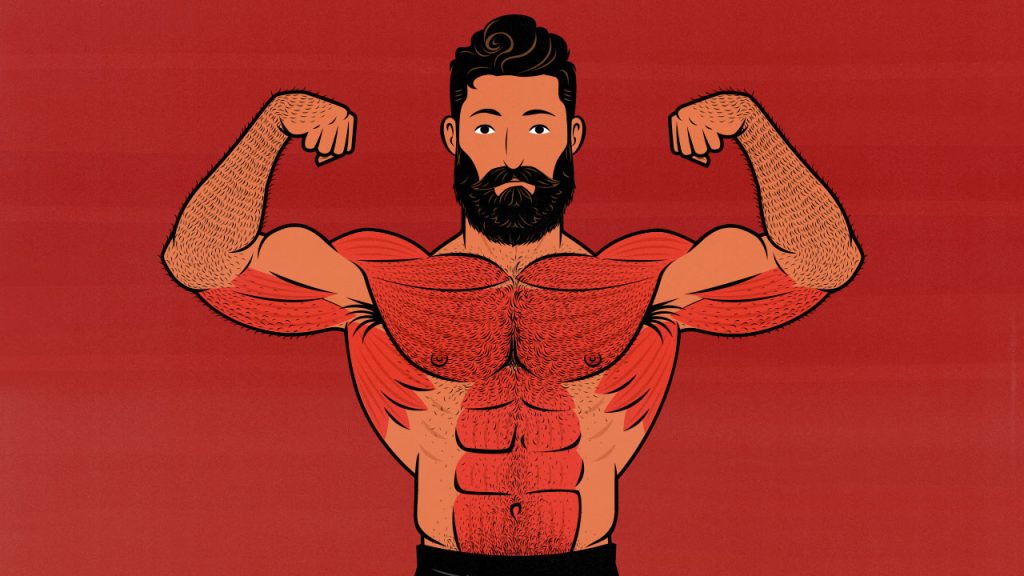
The Best Push Day Workout for Building Muscle
As an underweight beginner, I gained my first 20 pounds from doing poorly programmed Push Days. Only Push Days. No Leg or Back days. The only exercise I knew how to do properly was the push-up. That was enough to bring me up to a healthy body weight.
Another 40 pounds later, I used a Push Day specialization routine to accomplish my lifetime goal of benching 3 plates. My bench press had plateaued for years. What finally got it moving again was having 2 dedicated Push Days every week.
I love these workouts. They’re what sparked my love of lifting. They’re also quite simple to program.
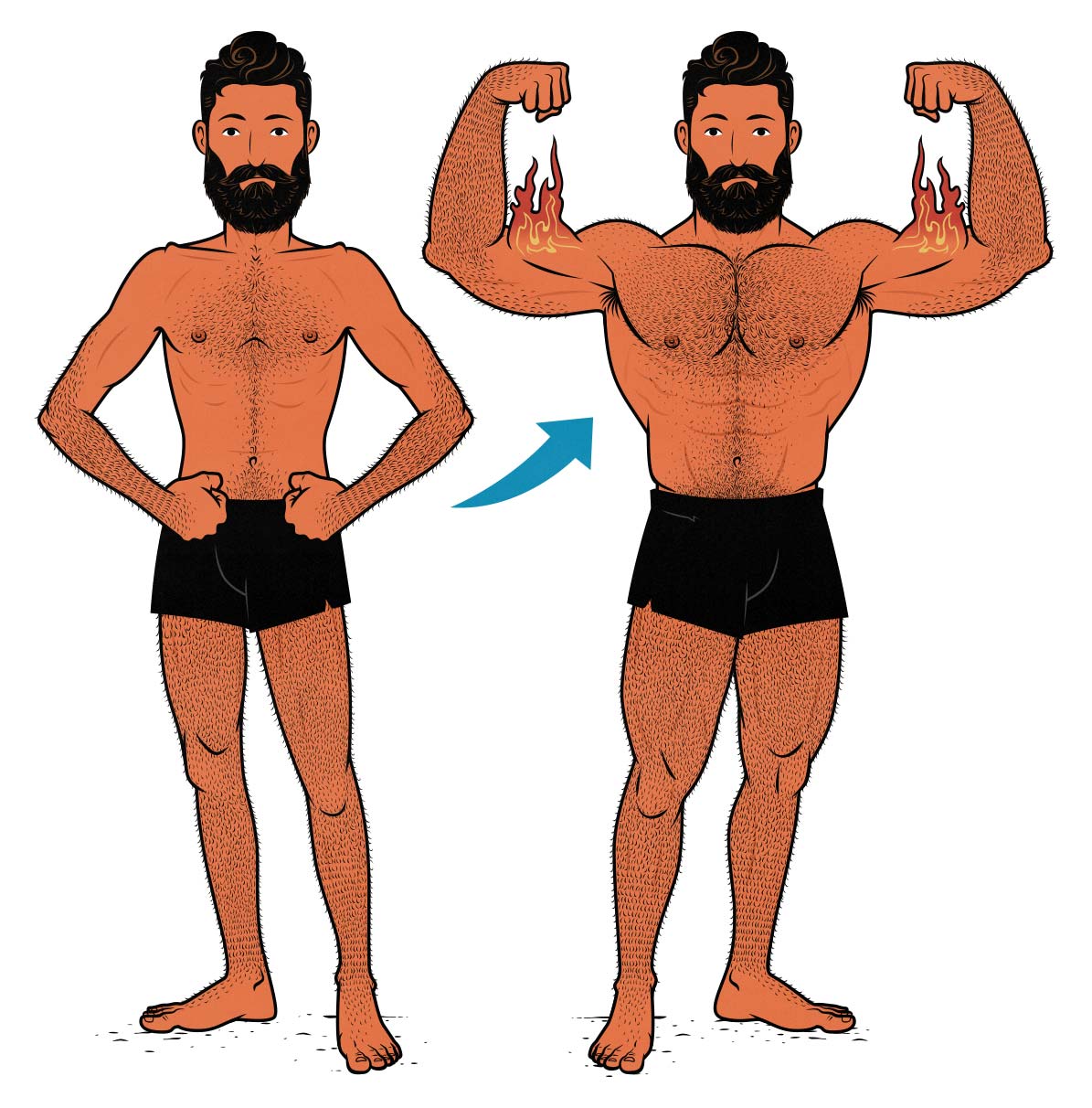
What’s A Push Day Workout?
A “Push Day” is a workout focused on the pushing movement pattern. Think of pressing exercises like push-ups, bench presses, and overhead presses, along with isolation exercises like triceps extensions, lateral raises, and chest flyes.
Push Days are part of body-part splits, where you split your body into different muscle groups, allowing you to train 4+ times per week without running into recovery issues. In this case, you’re training your pushing muscles hard while giving your other muscles a chance to rest.
You can do these workouts once or twice per week, depending on your workout split. We’ll give you options for both.
The Difference Between Push Day & Chest Day
Push Day and Chest Day aren’t always the same thing. Every Chest Day starts with a chest exercise (like a bench press), whereas some Push Days start with a shoulder exercise (like an overhead press). You could say that a Chest Day is a chest-focused Push Day.
Push Days and Chest Days are designed for different workout splits, too. Push Days slot into Push/Pull/Legs Splits along with Pull Days and Leg Days. Chest Days go into Bro Splits.
For more, we have articles about Chest Days and Bro Splits.
Muscles Worked During Push Days
A “Push Day” workout is a workout focused on the pushing movement pattern. Think of exercises like push-ups, bench presses, and overhead presses. These exercises all work the chest, shoulders, triceps, and, hopefully, the serratus anterior (underneath your armpits).
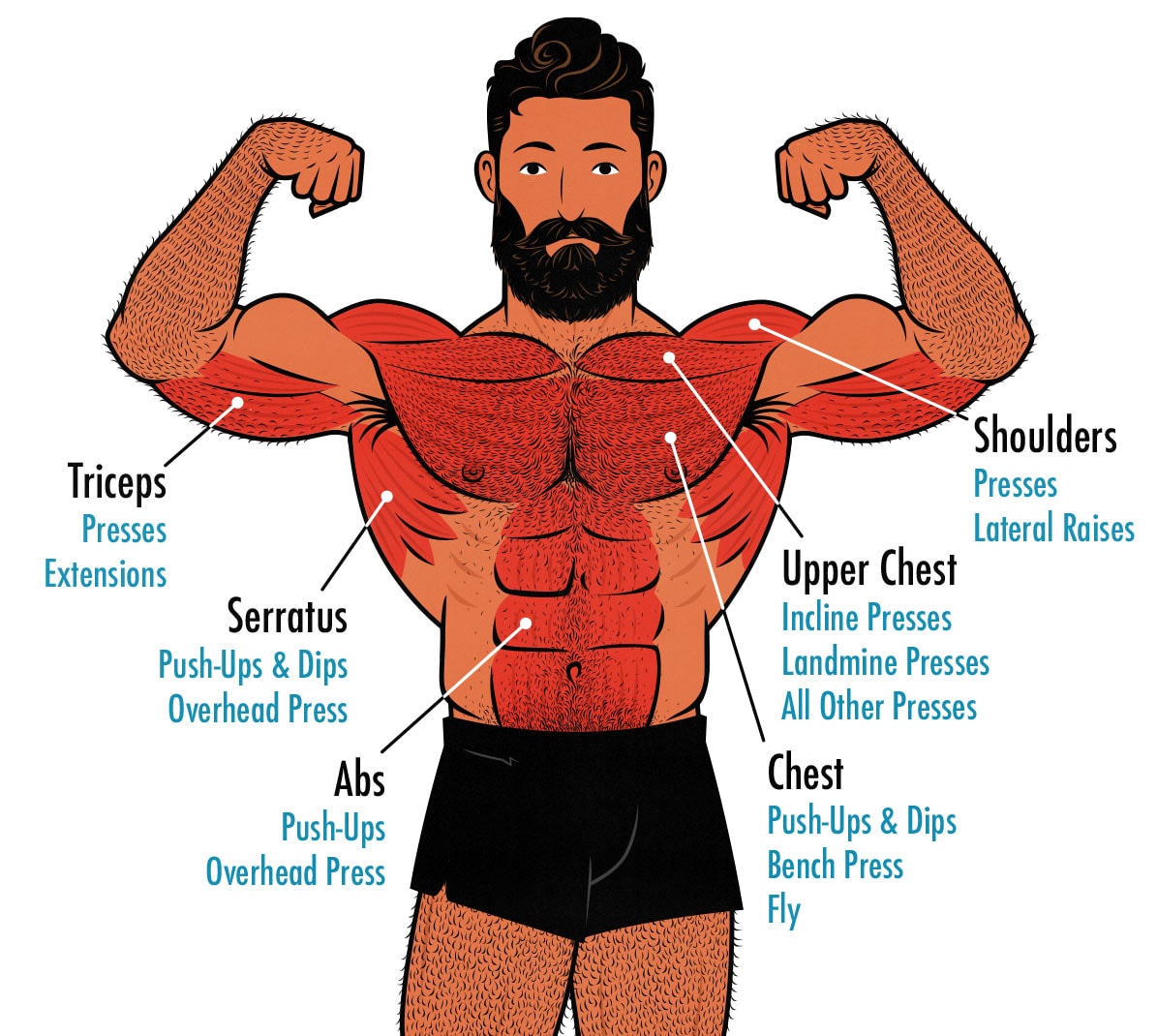
However, pushing exercises don’t do a very good job of training your side delts or the long heads of your triceps. As a result, a good Push Day workout will include some isolation lifts for those muscles, such as lateral raises and triceps extensions.
The Redundancy Mistake
The most common mistake people make when programming a Push Day workout is stacking redundant exercises on top of one another. They’ll do a barbell bench press, then a dumbbell bench press, then a chest fly. Those three exercises all train the same muscle fibres in the same way.
Instead, choose the horizontal pressing variation that suits you best, do as many sets as you need, then move to complementary exercises. For example, the dumbbell bench, then an incline bench, then an overhead press.
The Best Push Day Exercises
Push Day exercises can be broken down into 4 categories: horizontal pressing, vertical pressing, triceps extensions, and lateral raises. Pick one exercise from each category, then fill out the workout with whatever you please.
If you have two Push Days in your program, like in a 6-Day Push/Pull/Legs Split, you can give each workout a different emphasis. Maybe the first Push Day focuses more on horizontal pressing, whereas the other focuses more on vertical pressing.
Horizontal Pressing Exercises
Horizontal presses are the bedrocks upon which good Push Days are built. They work your entire chest, including your upper chest, as well as your front delts and the shorter heads of your triceps. If your shoulder blades are free to move, you can bulk up your serratus muscles, too.
There are a few good options. Here’s how to pick the best one:
- Push-Ups are ideal for novices. You can start with raised push-ups, then progress to regular push-ups, then raise your feet up. Push-ups are just as good for your chest and shoulders as the bench press, but they have the added advantage of working your core and serratus muscles, which are impressive muscles that improve your posture and protect your shoulder joints.
- Bench Presses are ideal when you can do 20 push-ups with your feet raised. You can use dumbbells or a barbell. Dumbbells let you go deeper and put more emphasis on your chest. The barbell is more stable and works your triceps harder.
- Dips give you the best of both push-ups and bench presses. They work your chest under a deeper stretch, they’re heavy, and they’re relatively easy to add weight to. If you can do dips, you should probably work them into your rotation. I recommend “chest” dips, leaning forward, almost like doing floating push-ups.
- Chest Press machines are a good alternative to bench presses. They aren’t better or worse than bench pressing, and sometimes they’re more convenient.
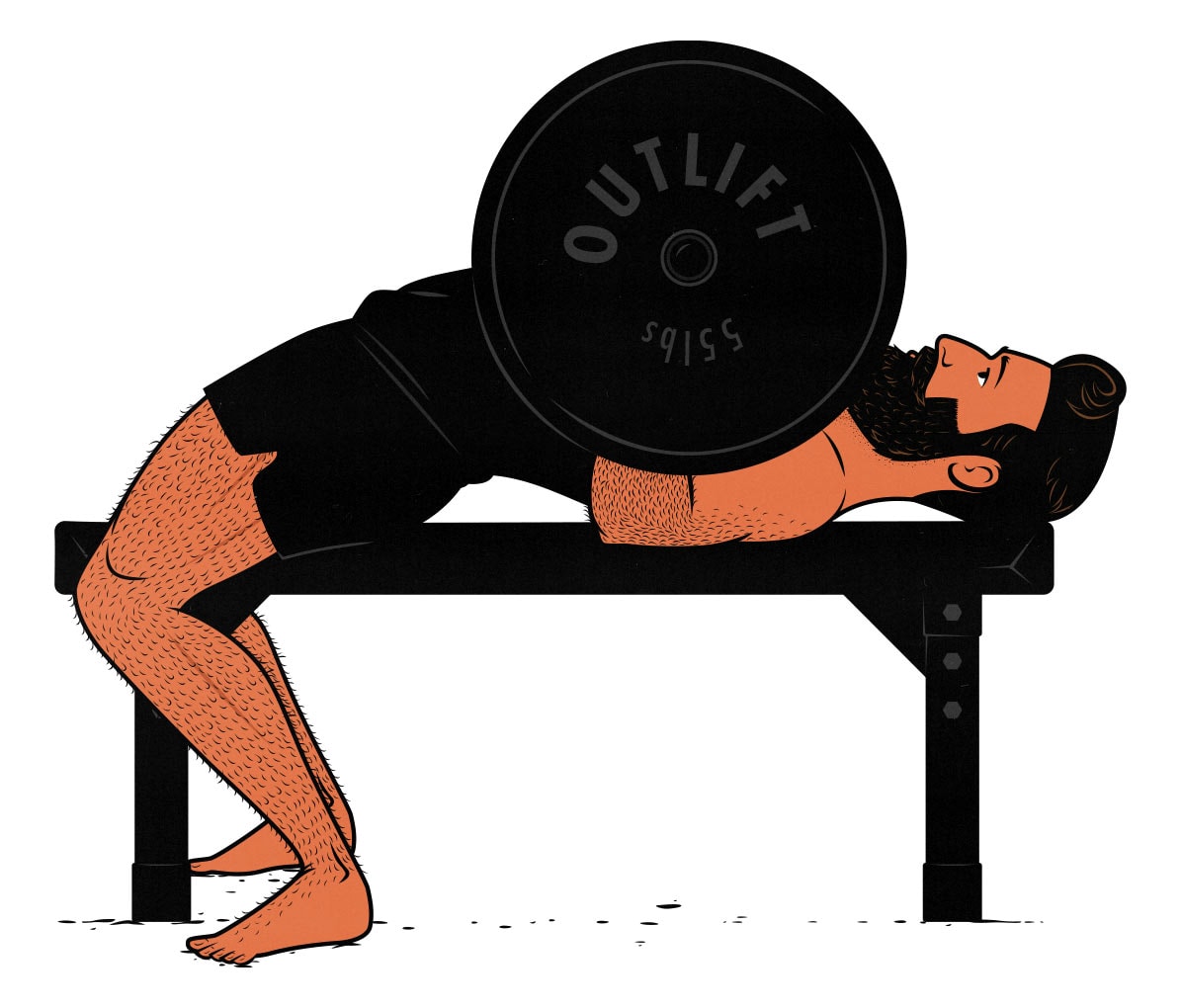
Vertical Pressing Exercises
Vertical presses seem like a push exercise, and they are, but they overlap with back and leg exercises, too. They work your upper chest, shoulders, and the shorter heads of your triceps. They also work your upper traps, core, and serratus muscles.
Here’s how to pick the best vertical press:
- Incline bench presses are good for beginners. They’re stable, easy to learn, and don’t require much shoulder mobility. You can use a machine, dumbbells, or a barbell.
- Landmine presses are good for performance. They’re less stable, harder to learn, and harder to set up, but they work your upper chest and shoulders just as hard, and they challenge your core and serratus muscles at the same time. When Marco was training professional and Olympic athletes, these were a favourite of his.
- Barbell overhead presses are great for overall size and strength. They’re great for your upper chest and shoulders, they work your serratus muscles, and they’re great for your core. They’re a huge compound exercise. Great for bulking up.
- Dumbbell Presses are good later in the workout. They’re great for your shoulders, great for mobility, and aren’t too hard on your core.
- Machine shoulder presses are convenient and effective. They’re easy to set up, easy to do, and work your shoulders quite hard.
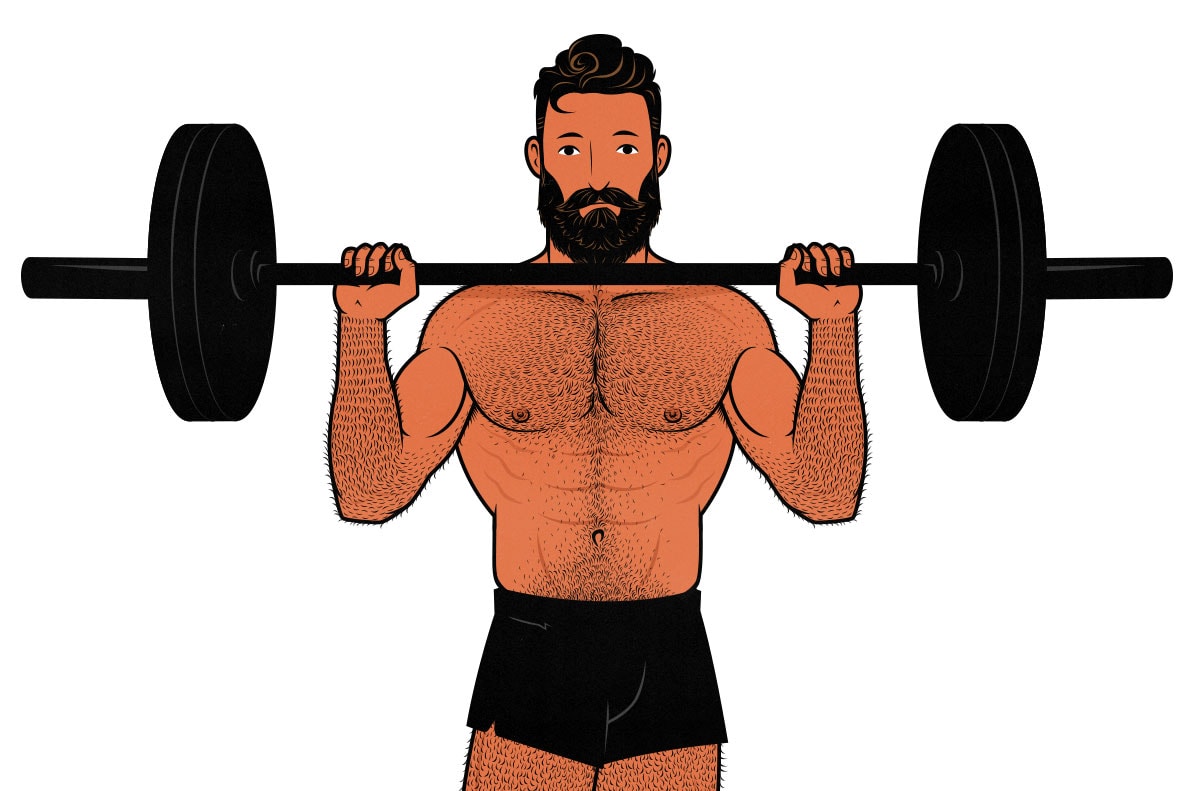
Triceps Extensions
Pressing movements can work your entire chest, but they can’t work all the heads of your triceps. The long heads of your triceps pull your elbows back. If you’re pressing your elbows forward, they can’t activate properly, as explained in our article on building bigger triceps. That’s why triceps extensions are so important (study).
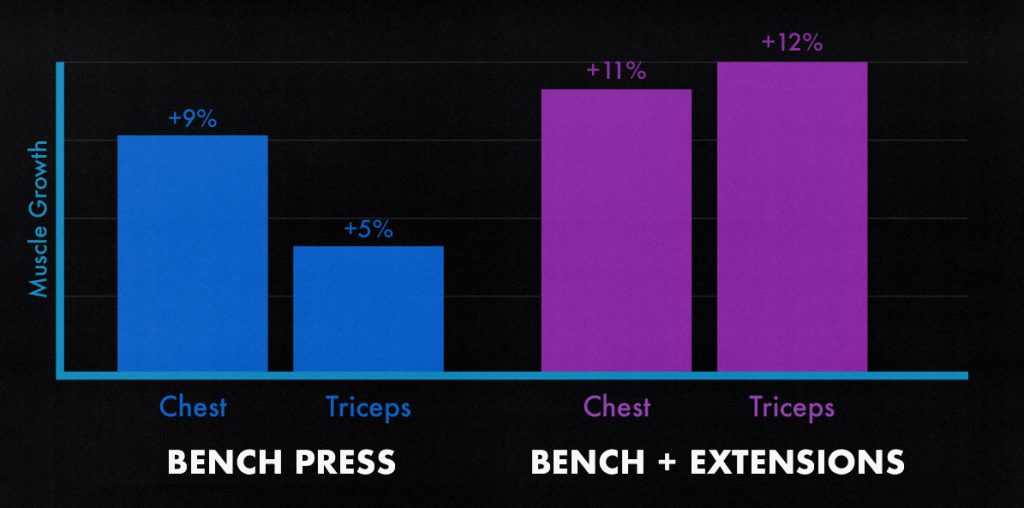
There are a few cool variations of triceps extensions. Here’s how to pick the best one:
- Triceps pushdowns are great for beginners. They’re easy to learn, they don’t require much shoulder mobility, they’re very safe, and they do a good job of working your triceps.
- Overhead extensions are the best for building muscle (study). If you have mobile shoulders and tough elbows, overhead extensions are fantastic for working the long heads of your triceps under a deep stretch. You’re stretching them at both the shoulder and elbow joint. I credit these for bringing my arms from 15 to 16 inches.
- Skull crushers are great for building a bigger bench press. They were a big part of bringing my bench press from 250 pounds to 315 pounds. They’re good for bulking up your triceps, too, but overhead extensions are probably better.
Lateral Raises
Lateral raises are a small but important exercise. Your side delts raise your arms out to the sides. Compound lifts don’t train that movement. By adding in a few quick sets of lateral raises 1–2 times per week, you can build much broader shoulders.
The classic lateral raise is done standing with dumbbells. That’s a perfectly fine variation. It’s a classic for a reason. But you can also do them lying down, working your side delts under a deeper stretch. Cables can come in handy here, too. Use whatever variation you prefer. The important thing is to do them.
The Chest Fly
You don’t need any chest isolation exercises in your routine. Your chest can be fully trained by pressing movements. Still, chest flyes can be a good way of giving your chest a bit of extra volume, especially if your pecs are hard to stimulate or are lagging behind.
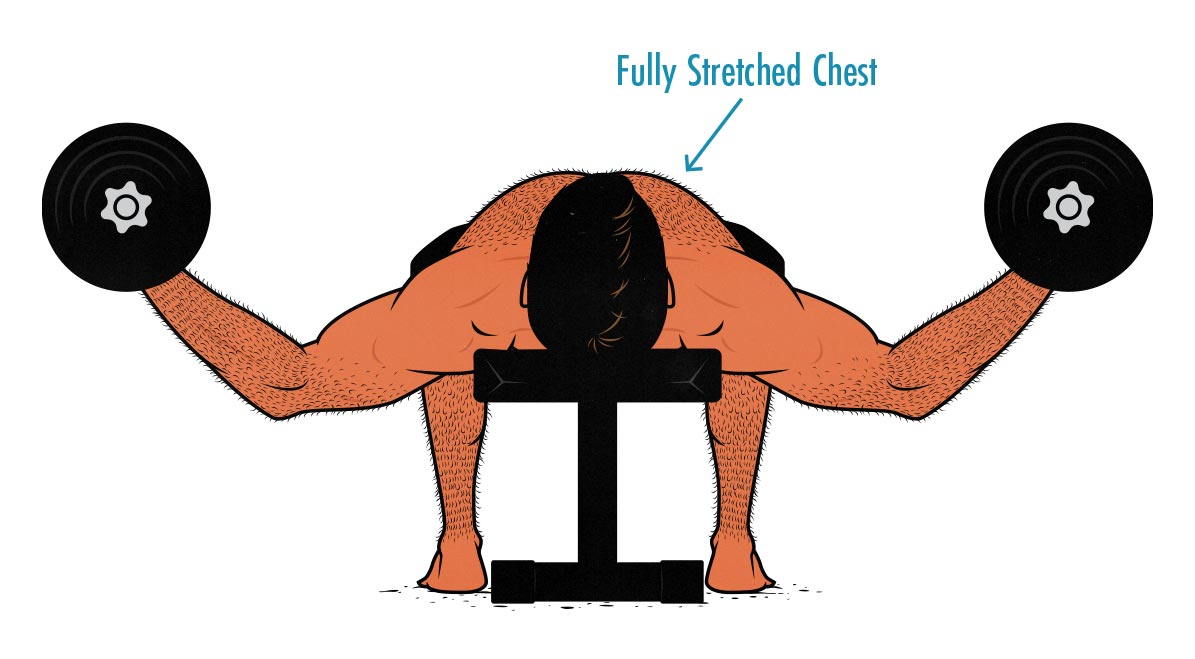
Cable chest flyes are often said to be ideal because they put tension on your pecs at the top of the range of motion. However, that isn’t where you’re stimulating muscle growth (meta-analysis). Deep is where the magic is, and that’s where dumbbell flyes are hardest. I suspect dumbbell flyes and machine flyes are better.
The Push Day Workout
The Classic Push Day Workout
| EXERCISE | SETS | REPS |
|---|---|---|
| Bench Press | 4–5 sets | 6-12 reps |
| Incline Bench Press | 3–4 sets | 8-12 reps |
| Overhead Triceps Extensions | 3–4 sets | 10-15 reps |
| Lateral Raises | 3–4 sets | 12–15 reps |
A classic Push Day workout is built around a horizontal press, such as the bench press, chest press machine, or, my personal favourite, the weighted dip.
The incline press, push-up, or landmine press comes next, giving your upper chest and front delts a bit more work. The overhead extensions are for your triceps. The lateral raises are for your side delts.
This workout may seem short, but it gives you a great lift for every Push muscle. This is enough for me and potentially for you as well. Still, you’re free to add more exercises to it.
The Maximalist Push Day Workout
| EXERCISE | SETS | REPS |
|---|---|---|
| Weighted Dips | 4–5 sets | 6-12 reps |
| Incline Bench Press | 3–4 sets | 8-12 reps |
| Overhead Dumbbell Press | 3 sets | 10-15 reps |
| Overhead Triceps Extensions | 3 sets | 10-15 reps |
| Lateral Raises | 3 sets | 12–15 reps |
| Chest Fly | 3 sets | 12–15 reps |
The maximalist Push Day workout has a pressing movement at every angle. Triceps extensions and lateral raises are needed to round out your triceps and shoulders. The chest fly is at the end for a bit of extra chest stimulation.
Most people won’t need this much volume or variation—I can fry my entire chest with 3 hard sets of dips—but some people definitely benefit from it. You probably know who you are.
The Minimalist Push Day Workout
| EXERCISE | SETS | REPS |
|---|---|---|
| Dips | 3–4 sets | AMRAP* |
| Overhead Triceps Extensions | 3 sets | 10-15 reps |
| Lateral Raises | 3 sets | 12–15 reps |
The minimalist Push Day workout is built on dips or push-ups. These are bodyweight exercises, meaning there’s very little setup, and you’ll barely even need to warm up. You can superset the triceps extensions and lateral raises together, saving even more time. Take every set to failure to ensure you still get a good stimulus. You can finish this workout in 20 minutes.
This is an 80/20 approach to stimulating your chest. It won’t be enough to fully maximise muscle growth. However, it should be enough to make progress. It should also be enough to maintain your gains, even while cutting.
I’ve used this exact routine for many months while focusing on other things, in or out of the gym. It’s a dear friend of mine. Treat it well.
If You Have Two Push Days
If you have two Push Days in your workout routine, you can build one around a horizontal press and the other around a vertical press.
| EXERCISE | SETS | REPS |
|---|---|---|
| Bench Press | 4–5 sets | 6-12 reps |
| Incline Bench Press | 3–4 sets | 8-12 reps |
| Skull Crushers | 3–4 sets | 10-15 reps |
| Lateral Raises | 3–4 sets | 12–15 reps |
The first workout starts with a dumbbell or barbell bench press. Next is an incline bench press or push-up. Skull crushers work well to support those pressing movements. You need the lateral raises for your side delts.
| EXERCISE | SETS | REPS |
|---|---|---|
| Overhead Press | 4–5 sets | 6-12 reps |
| Dips | 3–4 sets | AMRAP |
| Overhead Triceps Extensions | 3–4 sets | 10-15 reps |
| Lateral Raises | 3–4 sets | 12–15 reps |
The second workout starts with the overhead press for your shoulders and traps. I like to use the barbell overhead press or push press. Next come dips, either bodyweight or weighted, for your chest. Then overhead triceps extensions for bulking up your triceps, then lateral raises for your side delts.
These twin Push Days slot nicely into a 6-Day Push/Pull/Legs Split. I’ve also used them as part of a 3-day routine, with a full-body workout in the middle. That’s how I brought my bench press up to 3 plates. I did a close-grip bench press instead of dips, though, to keep it more similar to the bench press.
Push Day Training Guidelines
Every good muscle-building routine needs progressive overload. Fight to outlift yourself every workout, especially on the first exercise. Here are some other guidelines:
- Exercise Selection: These exercises are just defaults. Choose exercises that suit your body and your goals. If you prefer dips to bench presses, choose dips.
- Volume: We have 4 exercises in our main Push Day workout. This is probably enough to maximize your rate of muscle growth, provided you lift deep, hard, and properly. Some people benefit from more training volume than others, though, so we’ve given a minimalist and maximalist routine as well.
- Progression: The goal is to get progressively stronger at the first exercise of each workout. If you hit your rep targets last workout, add a little weight. If you’re still trying to add more reps, try to get more total reps than last time. For example, if you got 8, 7, 6, and 5 reps (26 reps) last workout, try to get 27+ reps this workout.
- Rest times: Classic Push Day workouts are done with moderate or short rest times. We recommend resting for 3 minutes between sets on the first exercise, 2 minutes between sets of other compound exercises, and 1 minute between sets of isolation exercises.
- Reps in Reserve: Push yourself hard on the first exercise, leaving 0–1 rep in reserve, ideally without failing your last rep. On the other exercises, leave 0-2 reps in reserve. I like to take the last exercise all the way to failure.
- Muscle-Building Diet: You need enough food to fuel muscle growth. If you’re skinny-fat or overweight, you can get extra energy from your body fat. If you’re thin or lean, you’ll need to get that energy from your food—you’ll need to gain weight.
Conclusion
Alright, that’s it for now. If you have any questions, drop them below. I’ll answer all the comments. If you want the latest research and methods in your inbox, we have a free muscle-building newsletter. Otherwise, press onwards and upwards!



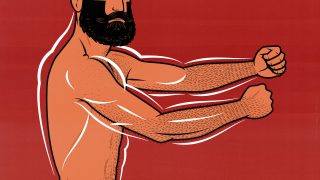
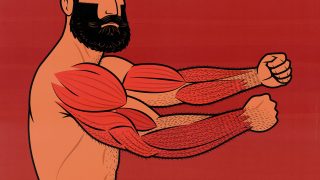
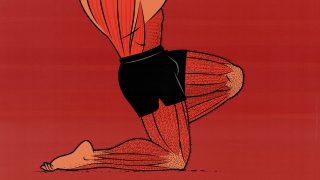

Great read men!
I wonder if close/diamond push ups are a reasonable solution to replace some of the triceps exercises, dips or close grip bench presses? This would save setup time comparing to the other options. They are heavy enough that most of us won’t need endless reps to be close to failure. Especially if programed as 3rd, 4th or 5th exercise.
Best regards
Sebastian
Thanks, Sebastian!
Close-grip and diamond push-ups put more emphasis on your triceps, but there’s still movement at the shoulder joint, meaning the long head can’t fully engage. You’ll develop 2 of the 3 heads of your triceps.
If you’re trying to improve your bench press or push-up performance, that isn’t a problem. You don’t need balanced triceps, you just need strong pressing muscles. But if you’re trying to build bigger arms or balanced triceps, it helps to have triceps exercises that don’t involve shoulder flexion. So think of exercises like triceps pushdowns, overhead extensions, skull crushers, and even the humble kickback.
Thanks for the quick reply and the details. I am with you. In the long run, arms need isolation work. Personally, I prefer skull crushers. Kickbacks are easy to learn, but I always doubted they were working. The strength curve seems mediocre at best. Very easy at the bottom, quite easy at the top, and hardest somewhere in the middle.
I hear ya. Kickbacks aren’t my favourite variation, either. I’m partial to overhead extensions. They train our triceps under the deepest stretch, have a fantastic strength curve, and have some research showing they’re great for the long head.
It has been a while since I did overhead extension. I should defintly give them a try in the future.